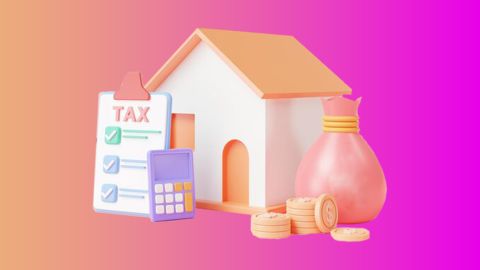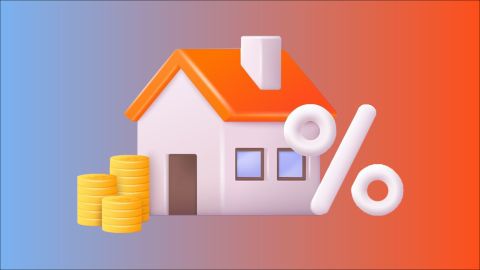In the complex landscape of taxation in India, certain provisions stand out as valuable tools for individuals seeking to optimise their financial planning. Among these provisions are the House Rent Allowance (HRA), a lifeline for those navigating the urban rental market, providing relief from accommodation expenses. Simultaneously, understanding how HRA and its corresponding deduction intersect with home loans is crucial for financial growth.
If you are in search of a new home and need financial assistance, consider Bajaj Finserv. Offering a wide range of home loan options, Bajaj Finserv caters to your specific needs. Whether you are a first-time home buyer or looking to upgrade, benefit from competitive rates, flexible repayment options, and hassle-free processes. With Bajaj Finserv, you can achieve your homeownership dreams seamlessly. You might already be eligible; check your home loan offers now by entering your mobile number and OTP.
HRA full form and meaning
House Rent Allowance (HRA) is a salary component paid by employers to employees to help them cover the cost of rented housing. It is offered only to those who live in rented accommodation and is eligible for tax benefits under Section 10(13A) of the Income Tax Act.
The amount of HRA offered can differ depending on where you live. Cities with a higher cost of living usually offer higher HRA. The exemption you can claim also depends on your salary, the actual rent you pay, and whether you live in a metro or non-metro city.
HRA helps reduce your taxable income if you qualify, making it a useful allowance for salaried individuals living in rented homes.
HRA calculation with example
The exempt amount of HRA is calculated by comparing three values, and selecting the lowest among them:
Actual rent paid – 10% of salary
HRA received from employer
City-based cap:
50% of salary for those living in metro cities (like Delhi, Mumbai, or Chennai)
40% of salary for those in non-metro cities
Let’s break this down with an example:
Assumptions
Basic salary: Rs. 50,000 per month
Dearness Allowance (DA): Rs. 10,000
HRA received: Rs. 12,000
Rent paid: Rs. 15,000
City: Delhi (metro)
Step-by-step calculation
Actual rent paid – 10% of salary (Basic + DA): Rs. 15,000 – Rs. 6,000 = Rs. 9,000
HRA received: Rs. 12,000
50% of salary (Basic + DA): Rs. 30,000
The exempt HRA is the lowest of these three: Rs. 9,000
So, the employee can claim Rs. 9,000 per month (Rs. 1,08,000 annually) as HRA exemption. This reduces their taxable salary, helping lower their overall tax liability.
Who can claim tax deduction on HRA?
You are eligible to claim HRA exemption if:
You are a salaried employee.
You receive HRA as part of your salary package.
You live in a rented house or flat.
The rent agreement or rent receipts are in your name.
Section 88GG – How to save tax if you do not receive HRA
If your salary package does not include HRA, you can still save on tax using Section 80GG. This benefit is mainly for salaried or self-employed individuals who pay rent but do not get HRA.
To claim this deduction:
You must not own any residential property in the city where you work.
You must be paying rent for accommodation.
Maximum deduction allowed (whichever is least)
Rent paid minus 10% of total income
25% of total income
Rs. 5,000 per month (i.e., Rs. 60,000 annually)
Documents needed
Rent receipts showing your name, landlord’s name, and address.
Proof of address (especially if staying away from your family home).
This provision is useful for those without HRA but still living on rent.
Understanding HRA deduction and its importance
The HRA deduction plays a pivotal role in tax planning for individuals, allowing them to claim a portion of their rental expenses as exempt from taxation. However, navigating the complexities of HRA calculation and deduction requires a clear understanding of the underlying principles and conditions set forth by tax regulations.
What is HRA and its components?
HRA, a component of the salary package provided by employers, is designed to cover the cost of rented accommodation. It is often a crucial part of an employee's compensation, particularly for those living in urban areas where rental expenses are high. HRA typically comprises three components: basic salary, dearness allowance (DA), and a variable portion known as special allowance. However, the actual HRA received may vary depending on the city of residence and the company's policies.
Breakdown of HRA calculation methods
Calculating an HRA deduction involves several factors, including the actual HRA received, salary, rent paid, and the city of residence. The Income Tax Act provides specific rules and conditions for determining the amount of HRA that can be claimed as a deduction. Three methods are commonly used to calculate HRA, namely:
- Actual HRA received: This method involves calculating the actual amount of HRA received from the employer. The least of the following amounts are considered for deduction: actual HRA received 50% of salary for those residing in metro cities or 40% for non-metro cities, and excess of rent paid over 10% of salary.
- Rent paid minus 10% of salary: Under this method, the difference between the rent paid and 10% of the salary is considered for HRA deduction. The least of the following amounts are deductible: rent paid minus 10% of salary, actual HRA received, or 50% of salary for metro cities and 40% for non-metro cities.
- 50% of salary: In this method, 50% of the individual's salary is considered for HRA deduction, provided they reside in metro cities. For non-metro cities, the percentage is reduced to 40%.
Formula for calculating HRA deduction
The formula for calculating HRA deduction depends on the method chosen. Here is a simplified version of the formula:
HRA deduction = \text{Minimum of (Actual HRA received, 50% of salary for Metro / 40% for non-metro, rent paid - 10% of salary)}
Conditions for claiming HRA deduction
To claim an HRA deduction, certain conditions must be met:
- The individual must be a salaried employee receiving HRA as part of their salary package.
- They must pay rent for accommodation where they reside.
- If the rent paid exceeds Rs. 1 lakh annually, the landlord's PAN details must be provided.
- HRA cannot be claimed if the individual resides in a self-owned property.
- Rent receipts and other relevant documents must be maintained as proof of rent paid.
Explore the HRA exemption calculator
Calculating HRA deduction manually can be complex, especially considering the various factors involved. Thankfully, several online tools, such as the HRA exemption calculator, simplify the process. By inputting details such as salary, rent paid, HRA received, and city of residence, individuals can accurately determine their HRA deduction eligibility and optimise their tax savings.
Can HRA be claimed together with interest on a home loan?
Yes, HRA (House Rent Allowance) and interest on home loan can be claimed together under different sections of the Income Tax Act.
HRA can be claimed as a tax exemption under Section 10(13A) of the Income Tax Act if you are a salaried employee and receive HRA from your employer as a part of your salary. However, if you are a self-employed individual or do not receive HRA from your employer, you cannot claim HRA as a deduction. On the other hand, interest on home loan can be claimed as a deduction under Section 24(b) of the Income Tax Act.
However, there are some situations where you may not be able to claim both deductions simultaneously. You cannot claim HRA if you are living in a house that is owned by you, your spouse or any other family member. In such a case, you can claim the deduction for interest on a home loan subject to certain conditions. Therefore, it is important to carefully understand the provisions of the Income Tax Act and claim the relevant deductions accordingly.
If you are considering availing of a home loan to purchase your dream home or meet other housing needs, Bajaj Finserv offers competitive interest rates, flexible repayment options, and hassle-free processesfor a seamless and convenient borrowing experience. Whether you are a first-time home buyer or looking to upgrade your existing home, Bajaj Finserv provides the financial support you need to achieve your homeownership goals.
Explore home loan options from Bajaj Finserv today and take a step closer to owning your dream home. You might already be eligible – check your offers by entering your mobile number and OTP for verification.
Popular calculators for your financial calculations




